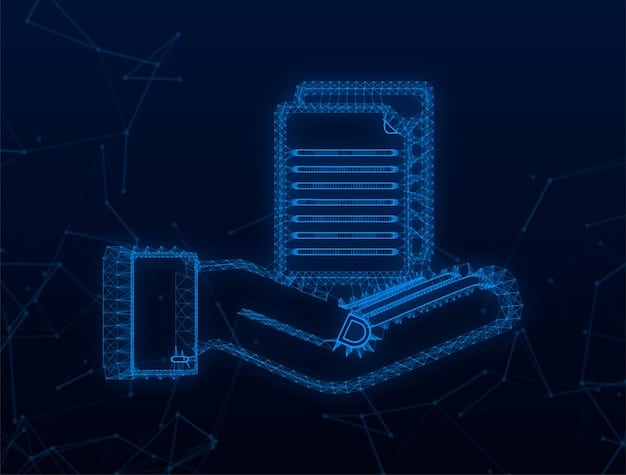US Tech Regulation: Navigating the Changing Landscape in 2025

The dynamic landscape of US tech regulation: navigating the changing landscape in 2025 is set to redefine how technology companies operate, emphasizing data privacy, antitrust, and content moderation in an evolving digital economy.
The digital age, while ushering in unprecedented innovation and connectivity, has simultaneously brought to the forefront complex questions regarding the power and responsibility of tech giants. As we approach 2025, the conversation around US tech regulation: navigating the changing landscape in 2025 intensifies, promising a transformative period for an industry that has largely operated with limited governmental oversight. This shift is not merely about curbing corporate power; it’s about reshaping the fundamental principles governing data, competition, and public discourse in the digital sphere, creating a challenging yet crucial environment for all stakeholders.
The Foundations of Legislative Scrutiny
The push for stronger tech regulation in the United States is not a sudden phenomenon but the culmination of years of growing concerns. From data breaches to accusations of monopolistic practices, the public and lawmakers alike have observed the exponential growth of tech companies and the broad societal impact they wield. This heightened scrutiny has laid the groundwork for a more interventionist approach, moving away from the previous era of self-regulation and toward a robust legal framework.
Several key historical events and legislative attempts have shaped the current regulatory climate. The European Union’s pioneering efforts with the General Data Protection Regulation (GDPR) served as a blueprint, demonstrating that comprehensive digital governance was not only possible but necessary. Domestically, high-profile congressional hearings involving tech CEOs have consistently highlighted the perceived need for greater accountability, fueling public debate and legislative momentum.
Historical Context and Building Blocks
The journey to the current regulatory climate began years ago, with early discussions around internet governance. Initially, the focus was on fostering innovation and growth, leading to a largely hands-off approach. However, as tech companies grew in size and influence, so did the concerns over their power.
- Section 230 of the Communications Decency Act: Originally intended to protect platforms from liability for user-generated content, it is now a major focal point for reform, with debates revolving around moderation standards and platforms’ roles.
- Antitrust Concerns: The historical precedent of breaking up monopolies in traditional industries is increasingly being cited in relation to tech giants, with calls for investigations into their market dominance.
- Data Privacy Laws: State-level initiatives like the California Consumer Privacy Act (CCPA) demonstrate a growing demand for individual control over personal data, pushing for federal action.
The legislative landscape is a complex tapestry woven from various threads of concern: privacy, competition, content moderation, and even national security. Each thread represents a distinct challenge that policymakers aim to address, often revealing the intricacies involved in regulating highly complex and rapidly evolving digital ecosystems. The balancing act between fostering innovation and protecting public interest remains a central dilemma for regulators.
The evolving regulatory environment reflects a maturation of understanding regarding the pervasive influence of technology. What began as a domain of niche enthusiasts has become a fundamental aspect of daily life, necessitating a more considered and comprehensive approach to its governance. The lessons learned from past regulatory failures and successes, both domestically and internationally, are now informing the strategies for 2025 and beyond.
Data Privacy: The Central Pillar of Future Regulation
In the realm of US tech regulation, data privacy stands as arguably the most critical and contentious issue. The collection, processing, and monetization of personal data by tech companies have raised significant ethical and legal questions, prompting a strong demand for robust protections. As 2025 approaches, an overarching federal data privacy law appears increasingly likely, consolidating fragmented state-level efforts and establishing a national standard.
This potential federal legislation is expected to encompass key provisions similar to those seen in GDPR and CCPA, granting individuals greater control over their personal information. This includes the right to access, correct, delete, and port their data, significantly empowering consumers and placing a heavier compliance burden on companies. The scope of such a law would likely extend to a wide range of industries that handle personal data, not just the large tech players.
Individual Rights and Corporate Responsibilities
The fundamental shift in data privacy regulation centers on recognizing data as an individual’s property, rather than merely a resource for companies to exploit. This philosophical change underpins the legislative push for stronger consumer rights.
- Right to Know: Consumers will likely gain the right to know what personal data is being collected about them, its source, and how it’s being used.
- Right to Delete: The ability to request the deletion of personal data held by companies will be a significant empowerment for individuals.
- Opt-Out Rights: Clear mechanisms to opt out of the sale or sharing of personal data, especially for targeted advertising, are expected to be mandatory.
For tech companies, compliance will necessitate significant overhauls of their data handling practices. This includes implementing stricter data security measures, clear consent mechanisms, and transparent data processing policies. Failure to comply could result in substantial fines, underscoring the seriousness of these impending regulations. The implications extend beyond legal frameworks, influencing how companies engage with their users and innovate their services in a privacy-conscious era.
Furthermore, the debate around data privacy extends to children’s online safety. Laws like the Children’s Online Privacy Protection Act (COPPA) may see enhancements or broader application, reflecting a growing societal awareness of the unique vulnerabilities of younger users in the digital world. This holistic approach to data privacy aims to build a more secure and trustworthy online environment for all users.
Antitrust and Market Dominance: Reshaping Competition
The debate over antitrust in the tech sector is not new, but it has gained unprecedented traction in recent years. Critics argue that a few dominant tech companies have accumulated too much power, stifling competition, hindering innovation, and controlling various aspects of the digital economy. As we move into 2025, robust antitrust enforcement and potentially new legislative tools are on the horizon, aiming to level the playing field.
Legislative proposals often revolve around concepts like “interoperability,” mandating that large platforms allow their services to work with smaller competitors, and “data portability,” enabling users to easily transfer their data between services. These measures are designed to reduce platform lock-in and foster a more dynamic competitive landscape. The long-term goal is to prevent the emergence of new monopolies and ensure that smaller innovators have a fair chance to thrive.
Strategies for Promoting Fair Competition
Policymakers are exploring a range of strategies to curb monopolistic behavior and promote a more competitive digital market. These strategies move beyond traditional antitrust enforcement, acknowledging the unique characteristics of the tech industry.
- Breaking Up Companies: Though a drastic measure, some proposals suggest the structural separation of certain business units within tech giants, particularly those that operate competing services.
- Merger Scrutiny: Increased scrutiny of mergers and acquisitions by dominant tech firms, ensuring that these deals do not eliminate nascent competitors.
- Self-Preferencing Bans: Legislation to prevent platforms from unfairly favoring their own products or services over those of competitors on their platforms.
The shift represents a reinterpretation of antitrust law for the digital age, moving beyond simple price effects to consider broader impacts on innovation, choice, and economic power. The challenge lies in crafting regulations that effectively promote competition without inadvertently stifling the very innovation that has driven the tech sector’s growth. The future of the digital economy hinges on finding this delicate balance.
Beyond legislative action, the Department of Justice and the Federal Trade Commission are expected to increase their enforcement actions, potentially leading to landmark lawsuits against tech giants. These legal challenges, combined with new statutory powers, could fundamentally alter the business models and market structures of the industry, fostering a new era of digital competition.
Content Moderation and Platform Accountability
The immense power of tech platforms in shaping public discourse has made content moderation a flashpoint for regulatory debate. From misinformation and hate speech to election interference, the scale and speed at which content spreads online demand a more nuanced approach to platform accountability. In 2025, policymakers are grappling with how to hold platforms responsible for the content they host without infringing on free speech principles.

A key area of focus is Section 230 of the Communications Decency Act, which currently grants platforms broad immunity from liability for user-generated content and their content moderation decisions. Proposals range from outright repealing it to introducing conditions for its protection, such as requiring greater transparency in moderation practices or imposing liability for specific categories of harmful content.
Navigating the Complexities of Online Speech
Balancing free speech with the need to combat harmful content is a formidable challenge for lawmakers. The solutions being explored reflect the difficulty in creating regulations that are both effective and constitutionally sound.
- Transparency Requirements: Mandating platforms to disclose their content moderation policies, enforcement actions, and algorithms that amplify content.
- Harmful Content Categories: Defining specific categories of content (e.g., incitement to violence, child exploitation) for which platforms would face stricter liability.
- Algorithmic Accountability: Examining the role of platform algorithms in amplifying or suppressing content and potentially regulating their design to mitigate harm.
The objective is not to dictate what can or cannot be said online but to create a framework where platforms assume greater responsibility for the ecosystem they foster. This involves a shift from simply hosting content to actively managing its impact, potentially requiring significant investments in human moderation and AI tools. The ongoing debate highlights the profound societal implications of digital speech and the urgent need for a cohesive regulatory approach.
Furthermore, international cooperation will be crucial in addressing cross-border content issues. The global nature of online platforms means that regulatory efforts in one country can have ramifications worldwide, underscoring the need for collaborative solutions to combat shared challenges like disinformation campaigns.
Emerging Technologies: AI, Web3, and the Unknown
Beyond the immediate concerns of data privacy, antitrust, and content moderation, the regulatory landscape for 2025 must also prepare for the rapid advancement of emerging technologies. Artificial intelligence (AI), Web3 components like blockchain and decentralized applications, and quantum computing – these innovations present unique regulatory challenges that demand foresight and adaptability.
AI, in particular, raises profound questions about ethics, bias, accountability, and the future of work. Governments are exploring frameworks for responsible AI development, focusing on transparency in algorithmic decision-making, ensuring fairness, and addressing potential societal impacts. The goal is to harness the transformative power of AI while mitigating its risks, setting the stage for future regulatory interventions.
Regulating the Unseen and Unfolding
The inherent uncertainty associated with nascent technologies makes their regulation particularly challenging. Policymakers are attempting to create agile frameworks that can adapt as these technologies evolve.
- AI Ethics and Bias: Developing guidelines and potentially regulations to ensure AI systems are fair, unbiased, and transparent in their operations, especially in critical areas like employment or credit.
- Web3 and Digital Assets: Clarifying the regulatory status of cryptocurrencies, NFTs, and decentralized autonomous organizations (DAOs), addressing issues of consumer protection, financial stability, and anti-money laundering.
- Quantum Computing’s Impact: Anticipating the national security and data encryption implications of quantum computing, and developing policies to safeguard critical infrastructure.
The approach to regulating emerging technologies is likely to be iterative, beginning with voluntary frameworks and industry standards, potentially progressing to more formal legislation as understanding deepens. This proactive stance aims to preempt potential harms and ensure that technological progress aligns with societal values. The challenge lies in fostering innovation without creating regulatory straitjackets that stifle future advancements.
Interagency collaboration will be paramount in addressing these complex areas, drawing expertise from various governmental bodies, academia, and industry stakeholders. This multidisciplinary approach is essential for creating comprehensive and effective regulatory strategies for the technologies that will define the rest of the 21st century.
The Global Ripple Effect: International Cooperation and Divergence
US tech regulation efforts do not exist in a vacuum. The global nature of technology means that domestic policies often have international implications, and vice versa. As the US charts its regulatory course, it will inevitably interact with and be influenced by frameworks emerging from the European Union, China, and other significant digital economies. This interplay will create both opportunities for cooperation and points of divergence.
The EU, with its pioneering GDPR and forthcoming Digital Services Act (DSA) and Digital Markets Act (DMA), has established itself as a global leader in tech regulation. US lawmakers are keenly observing these developments, often drawing inspiration from their comprehensive approach, particularly in areas like data privacy and market power. However, there are also fundamental differences in legal traditions and approaches that will shape distinct regulatory paths.
Harmonization vs. Fragmentation
The global regulatory landscape faces a critical juncture: will there be efforts towards international harmonization of tech laws, or will a fragmented patchwork of national regulations emerge?
- Brussels Effect: The EU’s robust regulations often have a global impact, as companies operating in the EU are compelled to adopt similar standards worldwide. The US may implicitly or explicitly align on certain aspects.
- Transatlantic Dialogue: Ongoing discussions between US and EU officials aim to bridge differences, particularly concerning data flows and competition policy, to facilitate trade and ensure regulatory compatibility.
- China’s Model: China’s state-centric approach to tech regulation, focusing on data sovereignty and national security, presents a contrasting model that will influence global debates, especially concerning supply chains and critical infrastructure.
The prospect of a fragmented global regulatory environment could create significant challenges for multinational tech companies, increasing compliance costs and complexity. Therefore, there is a strong incentive for international dialogue and, where possible, alignment on core principles, even if the specific implementation details vary. The long-term goal is to foster a stable and predictable global digital economy.
Moreover, the concept of “digital authoritarianism” versus “digital democracy” will likely become more pronounced, defining geopolitical alliances and rivalries in the tech sphere. The US regulatory approach will not only shape its domestic industry but also influence global norms and standards for the internet’s future.
Preparing for the Regulatory Future: What’s Next?
For tech companies, investors, and consumers, understanding and adapting to the impending regulatory changes is paramount. As 2025 draws near, the signs point to a sustained period of legislative activity and enforcement actions. This new era of regulation will demand not just legal compliance but also a deeper rethinking of business models, product design, and corporate responsibility.
Companies will need to invest significantly in legal and compliance teams, data privacy officers, and cybersecurity infrastructure. Proactive engagement with regulators and policymakers, rather than a reactive stance, will be crucial. Furthermore, the emphasis on transparency and accountability will necessitate a cultural shift within organizations, fostering an environment where ethical considerations are integrated into every stage of development.
Strategic Imperatives for Tech Stakeholders
Navigating the evolving regulatory landscape requires a strategic, forward-looking approach. Proactive measures will differentiate successful adaptations from those that stumble.
- Prioritize Privacy by Design: Integrating privacy protections into products and services from the outset, rather than as an afterthought, will be a fundamental shift.
- Diversify Business Models: Reducing reliance on data-intensive advertising models and exploring subscription, service, or hardware-focused revenues to mitigate future data privacy restrictions.
- Engage in Policy Advocacy: Actively participate in the regulatory debate, sharing insights and concerns to help shape pragmatic and effective legislation.
The regulatory future is not about stifling innovation but about directing it towards more socially responsible and equitable outcomes. This era will challenge tech companies to innovate not just in products and services but also in their governance and accountability structures. The businesses that embrace these changes as opportunities for growth and ethical leadership will be well-positioned for success in the regulated digital economy.
Ultimately, the aim of US tech regulation: navigating the changing landscape in 2025 is to create a digital world that is safer, fairer, and more competitive for everyone. While the path ahead is complex and filled with potential pitfalls, the commitment to these goals is clear, signaling a new chapter for the tech industry and its relationship with society.
| Key Point | Brief Description |
|---|---|
| 📊 Data Privacy | Anticipate a federal privacy law empowering consumers with data control rights, impacting how companies handle personal information. |
| ⚖️ Antitrust Focus | Increased scrutiny on market dominance, with potential for new laws promoting competition and preventing anti-competitive practices. |
| 🗣️ Content Moderation | Debates around Section 230 and platform accountability are evolving, aiming for greater transparency and responsibility for online content. |
| 🤖 Emerging Tech | AI, Web3, and other new technologies will face increasing regulatory attention, focusing on ethics, bias, and consumer protection. |
Frequently Asked Questions About US Tech Regulation in 2025
▼
The rapid growth and pervasive influence of tech companies across various aspects of society, coupled with concerns over data privacy, market dominance, and content integrity, are the primary drivers. Lawmakers aim to balance innovation with public interest and social responsibility.
▼
A new federal data privacy law would likely grant users more control over their personal data, including rights to access, correct, delete, and opt out of data sharing. This could lead to more transparent data practices from companies and fewer unsolicited data uses.
▼
While structural separation is a possibility being discussed, primary antitrust efforts in 2025 are more likely to focus on preventing anti-competitive practices like self-preferencing and scrutinizing mergers, aiming to foster fairer competition rather than immediate break-ups.
▼
Regulators face the complex challenge of balancing free speech principles with the need to combat harmful content like misinformation and hate speech. They seek to hold platforms accountable for content on their sites without becoming “arbiters of truth.”
▼
For AI and other emerging technologies, the US is likely to adopt an iterative approach, starting with ethical guidelines and industry standards, potentially moving to formal legislation as understanding deepens. The focus will be on ensuring fairness, transparency, and accountability.
Conclusion
The journey into 2025 marks a pivotal moment for US tech regulation: navigating the changing landscape in 2025, signifying a definitive shift from a largely unregulated digital Wild West to a more structured and accountable environment. This evolution is driven by a maturing understanding of technology’s societal impact, underscoring the urgent need to balance innovation with public trust, individual rights, and fair competition. As policymakers push forward with robust frameworks encompassing data privacy, antitrust, and content moderation, the tech industry faces a transformative period, demanding adaptability and a proactive approach to ethical governance. The future of the digital economy will undoubtedly be shaped by these evolving regulations, fostering a landscape where technological advancement aligns more closely with broader societal welfare.





